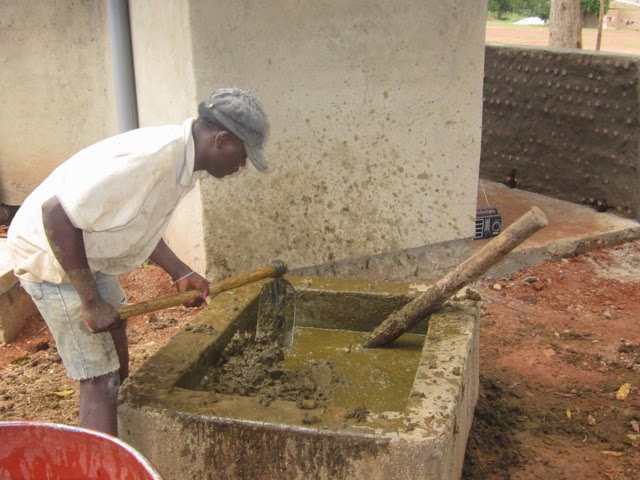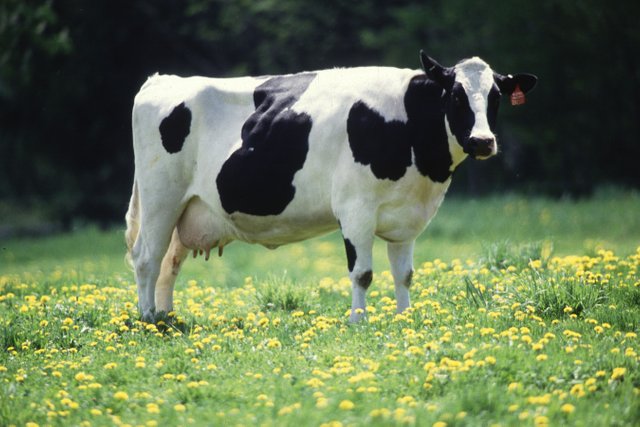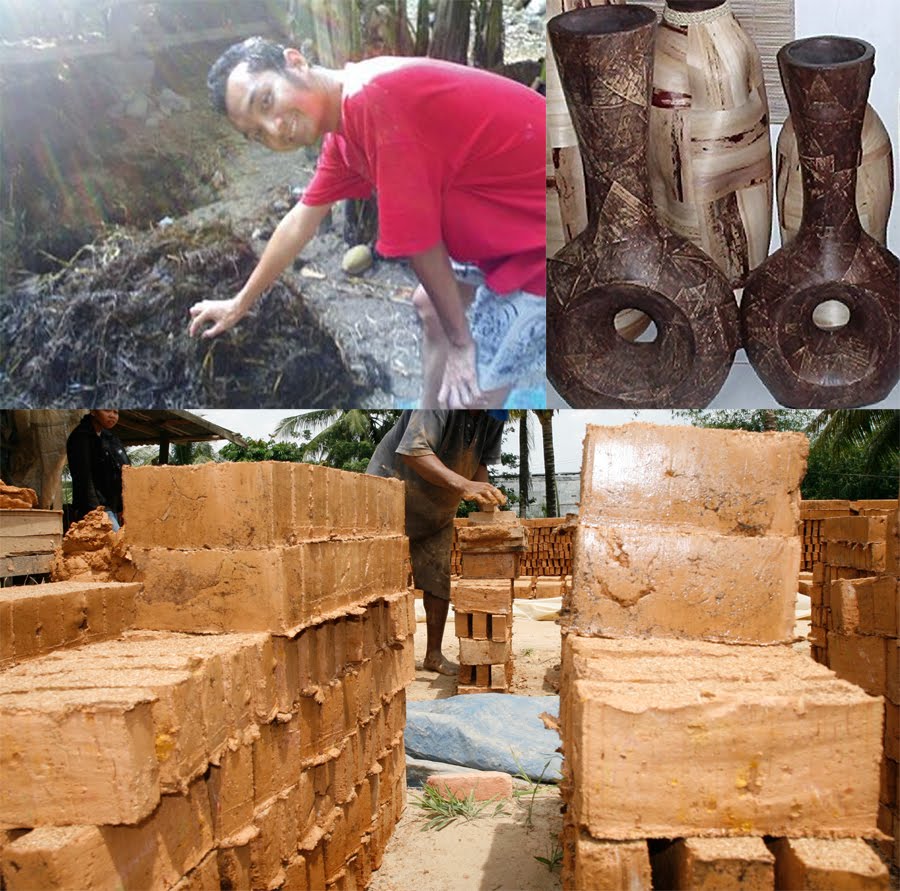Utilizing cow dung for construction materials
ENGLISH

Processing cow dung. Image source
Greetings, how are you steemit friends? Nice to meet again and hope you are healthy always. Today I will discuss the technology of construction materials, especially the renewable or green technology, considering the campaign to save the earth a top priority right now so we should also know what we should do, hopefully useful.
We already know some kind of environmentally friendly construction materials, whether using plastic waste, wood waste and so on.
Some time ago, UGM students managed to make bricks that are "very green" and won the competition [source]
, the renewable innovation they created is actually made of cow dung.
This strange-sounding technology is a very appropriate step for use in places where construction material is difficult to find, especially bricks.
Bricks made from cow dung have won the international competition (Global Social Competition Venture, Berkley University) in the United States in 2009.[source]
Before we continue the discussion, we should know more closely the animals producing this green brick material.

Cow female black white. Image source
As we know, cows are herbivorous animals used as livestock, cows have long been exploited by humans as meat producers can also help farmers to plow the fields.[source]
The cow are considered very useful animals, because almost all parts of the cow can be used by humans and even cow dung can be used as fertilizer in the field of agriculture, in some areas the cow can be used as a transportation animal so with all its excess cow has its own position on human civilization.
Cow's digestion produces impurities and can be used as a fuel called biogas can also be used as fertilizer, in some areas dry cow dung is also used as fuel. [source]
Cow dung is currently only used in Indonesia as fertilizer. Utilization of cow dung as fertilizer is considered good because of high cellulose.[source]
The cow world's largest producer.[source]
- India, with a population of 330,000,000 cows, makes India the world's largest cattle house with a percentage of about 25% of the world's cattle in India.
- Brazil, with a population of 208,000,000 cows. Brazil is listed as a supplier of 20% of the world's beef.
- China, with a population of 104,000,000 cows. China still has to import cows to meet domestic needs.
From that data we can count the results of cow dung in the three countries, assuming if one cow wet waste dumps with a weight of 0.5 Kg/day then with the number of cows 642,000,000 head then the total wet dirt produced is 321,000,000 Kg/day or 321,000 tons /day. Wow full of cow dung. In fact cow dung per day more than 1 Kg/day and will lose weight when dry up to 40%. [source]
The results suggest that unprocessed cow dung can trigger the rise of geothermal and others [source], other things that can affect health if consuming water that has been contaminated with cow dung.
So to reduce these impacts besides being used as fertilizer and biogas, cow dung can also be used for construction materials.
As I mentioned above, this discovery is a very smart innovation to save the earth, though it is strange.
Brick from cow dung has actually been done by Syammahfuz who came from UGM agriculture faculty with friends since 2006 but only in 2009 through the prestigious competence of international level this technology is known.[source]
From various studies and experiments, finally the bricks of cow dung can be used as conventional bricks that we know, cow dung bricks are also claimed to be odorless and itchy.
The advantages of using bricks from cow dung.[source]
- Lighter than conventional brick
- Environmentally friendly
- Stronger than conventional brick
- Cheap
- Abundant material
The process of making bricks from cow dung is actually still considered a secret because until now the inventors still have not managed to have a patent on his work. But in general, can be said the brick making process is almost the same as making bricks from clay.
The process of making bricks from cow dung.[source]
- The basic composition consists of, 80% dried cow dung and 20% clay.
- The composition is formed to unite like a dough.
- Pour the dough into the mold.
- Dry to change color
- Burn until the brick is completely dry.
- Bricks you can use.
Actually, there are still some mixtures that are not mentioned by the inventor of this technology to make the brick is odorless, strong and durable.
Currently, brick technology from cow manure by Syammahfuz and his friends has been in demand by international markets, such as the Netherlands and so on.[source]

Cow dung can cause negative impacts on the earth, such as triggering the rise of geothermal and so on, so it is advisable to process cow dung to reduce it.
With the background of saving the earth from environmental pollution and creating environmentally friendly technology finally UGM students managed to create bricks from cow dung.
Given the lack of utilization of cow dung for construction materials that "green" makes this technology an appropriate alternative at this time.
Using this technology means you have minimized the impact of environmental pollution and saved our child's future.
BAHASA

Kotoran sapi sedang di olah. Image source
Salam, apa kabar teman steemit? Senang berjumpa kembali dan semoga anda sehat selalu. Hari ini saya akan berdiskusi tentang teknologi material konstruksi khususnya yang terbarukan atau green technology, mengingat kampanye menyelamatkan bumi menjadi prioritas utama saat ini maka sepantasnya kita juga mengetahui apa yang sebaiknya kita lakukan, semoga bermanfaat.
Kita telah mengetahui beberapa jenis material konstruksi yang ramah lingkungan, baik memanfaatkan limbah plastik, limbah kayu dan lain sebagainya.
Beberapa waktu lalu, mahasiswa UGM (Indonesia) berhasil menciptakan bata yang “sangat hijau” dan memenangkan sebuah kompetisi [source], inovasi yang terbarukan tersebut sebenarnya terbuat dari kotoran sapi.
Teknologi yang terdengar aneh ini merupakan langkah yang sangat tepat untuk digunakan di tempat yang sulit memperoleh material konstruksi khususnya bata.
Bata yang terbuat dari kotoran sapi ini telah memenangkan kompetisi tingkat internasional (Global Social Competition Venture, Universitas Berkley) di Amerika pada tahun 2009. [source]
Sebelum kita melanjutkan pembahasan, sebaiknya kita mengenal lebih dekat hewan penghasil material bata hijau ini.

Sapi betina hitam putih. Image source
Seperti yang kita ketahui, sapi merupakan hewan herbivora yang dijadikan hewan ternak, sapi telah lama dimanfaatkan oleh manusia sebagai penghasil daging juga dapat membatu petani untuk membajak sawah.[source]
Sapi dianggap hewan yang sangat bermanfaat, karena hampir seluruh bagian sapi dapat digunakan oleh manusia bahkan kotoran sapi dapat dimanfaatkan sebagai bahan pupuk pada bidang pertanian, di beberapa daerah sapi dapat dimanfaatkan sebagai hewan transportasi sehingga dengan segala kelebihannya sapi memiliki posisi tersendiri pada peradaban manusia.
Buangan pencernaan sapi menghasilkan kotoran dan bisa dimanfaatkan sebagai bahan bakar yang disebut biogas juga dapat dimanfaatkan sebagai pupuk, pada beberapa daerah kotoran sapi kering juga digunakan sebagai bahan bakar.[source]
Kotoran sapi saat ini di Indonesia biasanya hanya digunakan sebagai pupuk. Pemanfaatan kotoran sapi sebagai pupuk dianggap baik karena tinggi akan selulosa.[source]
Negara penghasil sapi terbesar di dunia.[source]
- India, dengan populasi 330,000,000 sapi, menjadikan india sebagai rumah sapi terbanyak di dunia dengan persentase sekitar 25% sapi dunia berada di India.
- Brazil, dengan populasi 208,000,000 sapi. Brazil tercatat sebagai pemasok 20% daging sapi dunia.
- China, dengan populasi 104,000,000 sapi. China tetap harus mengimpor sapi untuk memenuhi kebutuhan domestik.
Dari data tersebut dapat kita hitung hasil kotoran sapi tersebut di tiga negara tersebut, asumsi jika satu sapi menghasilkan kotoran basah dengan berat 0,5 Kg/hari maka dengan jumlah sapi 642,000,000 ekor maka total kotoran basah yang dihasilkan adalah 321,000,000 Kg/hari atau 321,000 ton/hari. Wow penuh dengan kotoran sapi.Faktanya kotoran sapi perhari lebih dari 1 Kg/hari dan akan kehilangan berat saat kering hingga 40%.[source]
Hasil penelitian menyebutkan bahwa kotoran sapi yangtidak diolah dapat memicu naiknya panas bumi dan lain sebagainya [source], hal lain yang dapat mempengaruhi kesehatan jika mengkonsumsi air yang telah terkontaminasi dengan kotoran sapi.
Sehingga untuk mengurangi dampak tersebut selain dimanfaatkan sebagai pupuk dan biogas, kotoran sapi juga dapat digunakan untuk material konstruksi.
Seperti yang telah saya sebutkan diatas, bahwa penemuan ini merupakan inovasi yang sangat cerdas untuk menyelamatkan bumi, walau terdengat aneh.
Bata dari kotoran sapi sebenarnya telah dilakukan oleh Syammahfuz yang berasal dari fakultas pertanian UGM bersama temannya sejak 2006, tetapi baru tahun 2009 melalui kompetensi bergengsi tingkat internasional teknologi ini dikenal.[source]
Dari berbagai penelitian dan percobaan, akhirnya saat ini bata dari kotoran sapi dapat digunakan seperti bata konvensional yang kita kenal, bata kotoran sapi juga diklaim tidak berbau dan gatal.
Keuntungan menggunakan bata dari kotoran sapi. [source]
- Lebih ringan dari bata konvensional
- Ramah lingkungan
- Lebih kuat dari bata konvensional
- Murah
- Material yang melimpah
Proses pembuatan bata dari kotoran sapi sebenarnya masih dianggap rahasia, karena hingga kini para penemu masih belum berhasil memiliki paten atas karyanya tersebut. Namun secara umum dapat dikatakan proses pembuatan bata ini hampir sama dengan pembuatan bata dari tanah liat.
Proses pembuatan bata dari kotoran sapi.[source]
- Komposisi dasar terdiri dari, 80% kotoran sapi kering dan 20% tanah liat.
- Komposisi tersebut dibentuk hingga menyatu seperti adonan.
- Tuangkan adonan tersebut ke cetakan.
- Keringkan hingga berubah warna
- Bakar sampai bata benar-benar kering.
- Bata sudah bisa anda gunakan.
Sebenarnya masih ada beberapa campuran yang tidak disebutkan oleh penemu teknologi ini untuk membuat bata tersebut tidak berbau, kuat dan awet.
Saat ini teknologi bata dari kotoran sapi karya Syammahfuz dan temannya telah diminati oleh pasar Internasional, seperti Belanda dan lain sebagainya.[source]

Kotoran sapi dapat menyebabkan dampak negatif terhadap bumi, seperti memicu naiknya panas bumi dan lain sebagainya, sehingga sangat dianjurkan untuk mengolah kotoran sapi untuk mengurangi dapak tersebut.
Dengan latar belakang menyelamatkan bumi dari pencemaran lingkungan dan menciptakan teknologi ramah lingkungan akhirnya mahasiswa UGM berhasil menciptakan bata dari kotoran sapi.
Mengingat masih minimnya pemanfaatan kotoran sapi untuk material konstruksi yang”green” menjadikan teknologi ini alternatif yang tepat saat ini.
Dengan menggunakan teknologi ini berarti anda telah meminimalisir dampak pencemaran lingkungan dan menyelamatkan masa depan anak kita.
This is the only thing I can write on this occasion, over all the mistakes and lack of unintentional writing as a servant of God, I apologize.
Thanks to friends who have visited this blog and provided constructive comments, as well as scientists who are willing to sacrifice their time for a better civilization.
Active link reference:
www.kyqie-rizqie.blogspot.co.id
Do you love science? by respecting the work of others and not plagiarism then you are welcome to join steemSTEM by using #science tags, you can also chat with us in steemit chat/steemSTEM channel.

Jika anda pengguna bahasa Indonesia, maka anda bisa bergabung dengan kami indo-STEM dan di discord https://discord.gg/Mxcz6z
Best Regards @kharrazi
A great post @kharrazi.
thank you :)
I didn't know you could build a house with moo poop! :P
no...no, i just tell people
Hahaha XD
Import or domestic cow ?
as long they produces cow dung! No problem, domestic or import :)
nyan that gura, bagian lawok ek lumo keu material.....hahahah
teungoh geu render bang nyan, tema green arsitektur...ahahhaha
Nan jih v leumo ray :D